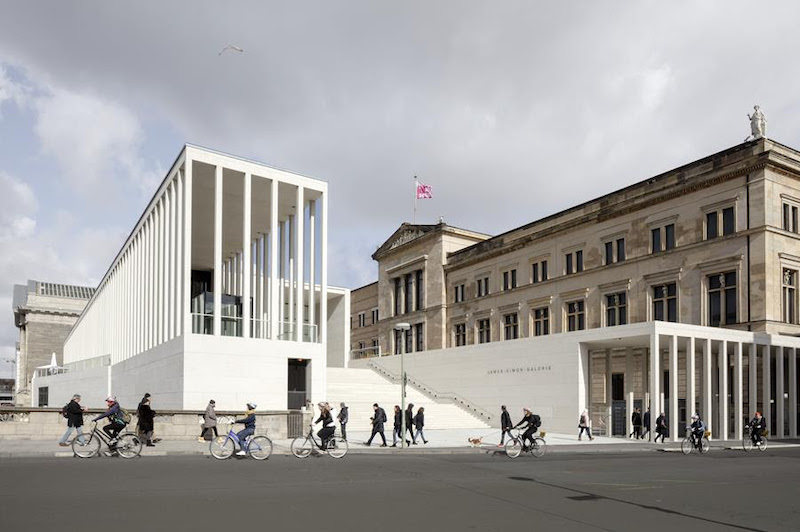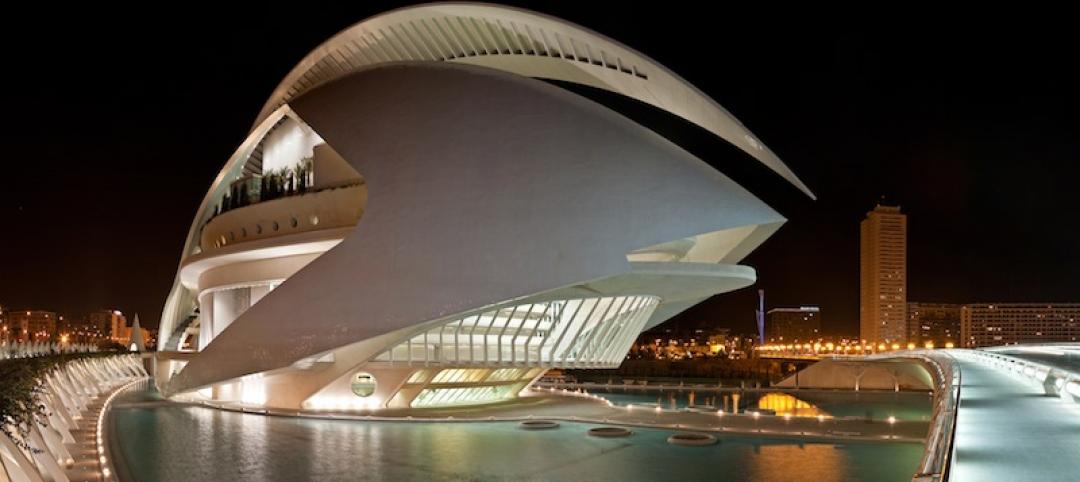The James-Simon-Galerie, the first new building on Berlin’s Museum Island in nearly 100 years, opened to the public on July 13, 2019 and acts as the new entrance building to the island. The building sits at a key location in front of or behind the Neues Museum and Pergamon Museum, complementing the interplay of spatial alignments on the island and reorientating it towards the city.
The project plays an essential role in the Museum Island master plan and links four of the five museums via the Archaeological promenade below ground (the project includes 3 above ground levels, one mezzanine, and two below ground levels). The master plan sets a framework for developing a modern museum complex while preserving the unique historical ensemble, and the James-Simon-Galerie does just that by providing a contemporary aesthetic that blends in with the surrounding museums.
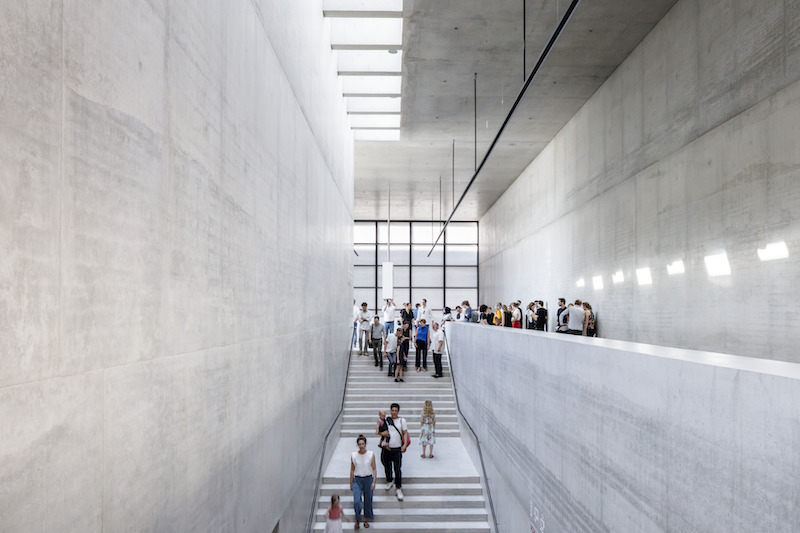 Upper foyer, main internal staircase. Photo: © Ute Zscharnt for David Chipperfield Architects.
Upper foyer, main internal staircase. Photo: © Ute Zscharnt for David Chipperfield Architects.
The primary façade material is cast stone. An aggregate made of white marble gravel from Saxony lends the entrance building its tonality, integrating it into the diversity of materials on Museum Island. Behind the building's columns, the envelop is glazed, and stabilized by eight-meter-high vertical façade supports, themselves made from glass.
See Also: POST Houston mixed-use development will include a five-acre “skylawn”
Inside, the structure is characterized by textured surfaces, in particular smooth in-situ concrete walls in fair-face concrete and floors made of bright Crailsheim shell limestone. The mezzanine floor and the auditorium have smoked oak parquet flooring. Bronze was used for window profiles, doors and handrails throughout the building. A copper braid was used on selected ceilings, including in the café.
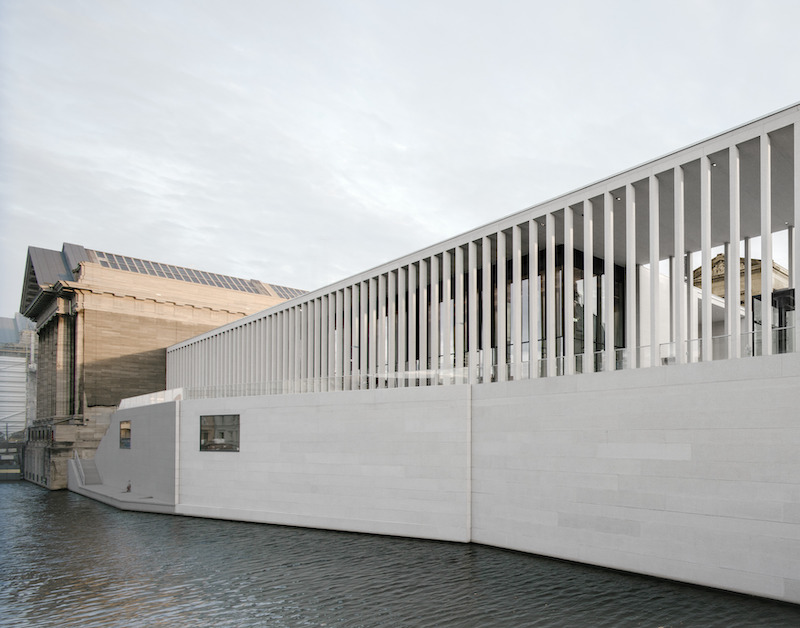 Plinth and tall colonnade (92 columns). Photo: Photo: © Simon Menges.
Plinth and tall colonnade (92 columns). Photo: Photo: © Simon Menges.
The 10,900-sm building was designed to welcome large numbers of visitors and to house all the facilities required by contemporary museum-goers. The James-Simon-Galerie also includes divisible temporary exhibition space and a 350-seat auditorium. Outside of museum hours, a grand staircase, a terrace with café, and a new courtyard will be accessible to the public.
Revolving doors and draft lobbies help minimize heat loss despite the expected high frequency of visitors. The use of radiant building components implemented in the plant technology of the building uses thermally activated surfaces to cover the base load in heating and cooling, reducing the air volume flows. A thermally active and acoustically absorbent ceiling with a copper mesh cladding, which was used in selected areas, also has a positive effect.
Museum Island has been a UNESCO World Heritage site since 1999 and is visited by about three million people every year.
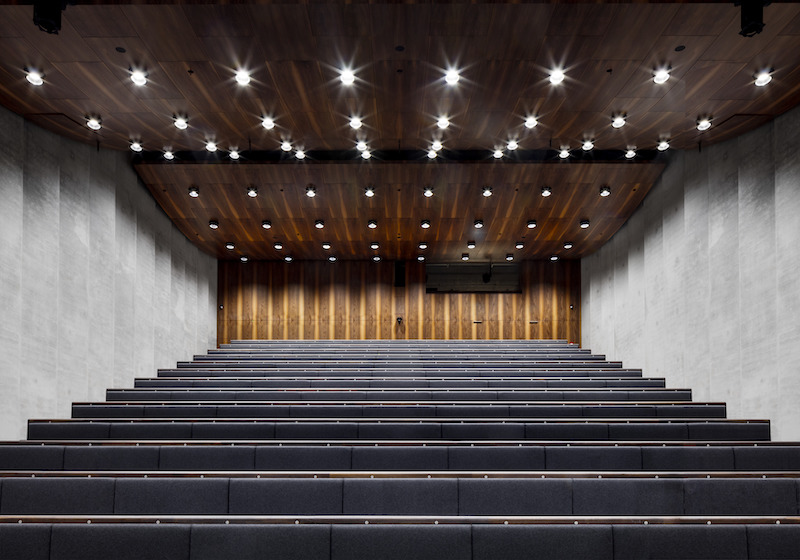 Auditorium. Photo: © Ute Zscharnt for David Chipperfield Architects.
Auditorium. Photo: © Ute Zscharnt for David Chipperfield Architects.
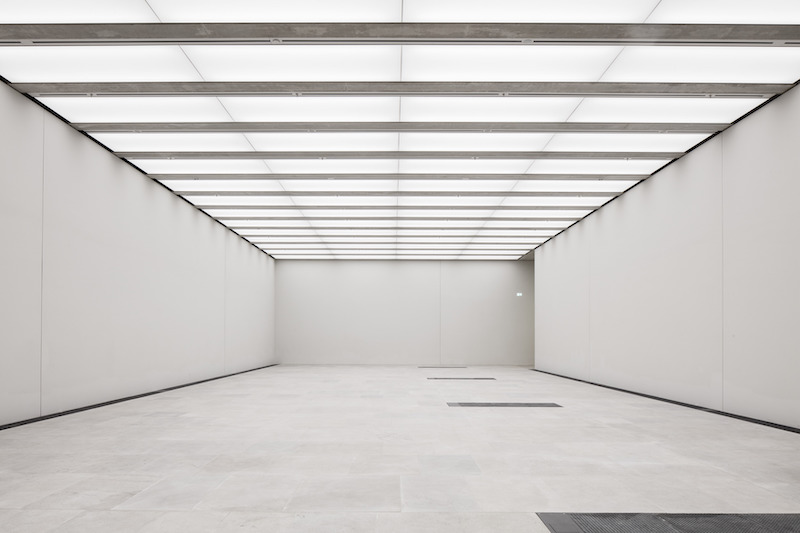 Temporary exhibition space. Photo: © Ute Zscharnt for David Chipperfield Architects.
Temporary exhibition space. Photo: © Ute Zscharnt for David Chipperfield Architects.
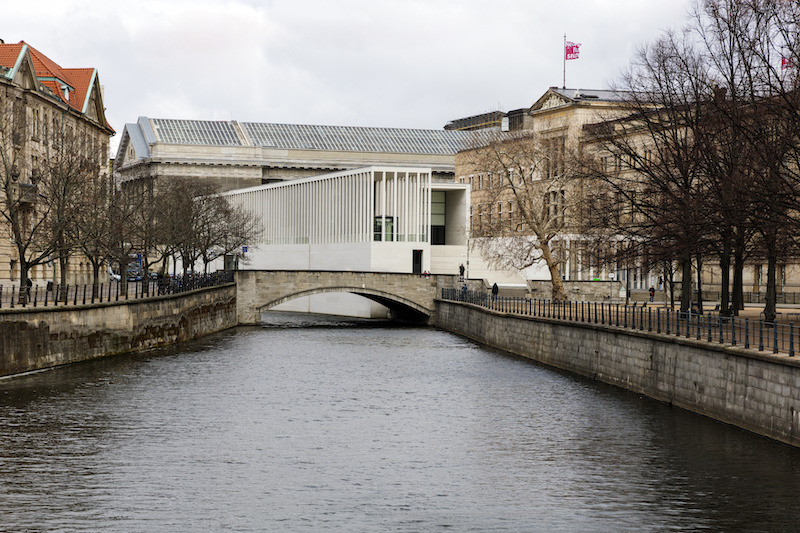 View from Schlossbrücke. Photo: © Ute Zscharnt for David Chipperfield Architects.
View from Schlossbrücke. Photo: © Ute Zscharnt for David Chipperfield Architects.
Related Stories
| Jan 28, 2014
Big Ten Conference opens swanky HQ and museum [slideshow]
The new mixed-use headquarters includes a museum, broadcast studios, conference facilities, office spaces, and, oh yeah, a Brazilian steakhouse.
| Jan 13, 2014
Custom exterior fabricator A. Zahner unveils free façade design software for architects
The web-based tool uses the company's factory floor like "a massive rapid prototype machine,” allowing designers to manipulate designs on the fly based on cost and other factors, according to CEO/President Bill Zahner.
| Jan 11, 2014
Getting to net-zero energy with brick masonry construction [AIA course]
When targeting net-zero energy performance, AEC professionals are advised to tackle energy demand first. This AIA course covers brick masonry's role in reducing energy consumption in buildings.
| Dec 30, 2013
Calatrava facing legal action from his home town over crumbling cultural complex
Officials with the city of Valencia, Spain, are blaming Santiago Calatrava for the rapid deterioration of buildings within its City of Arts and Sciences complex.
| Dec 19, 2013
Mastering the art of crowd control and visitor flow in interpretive facilities
To say that visitor facility planning and design is challenging is an understatement. There are many factors that determine the success of a facility. Unfortunately, visitor flow, the way people move and how the facility accommodates those movements, isn’t always specifically considered.
| Dec 13, 2013
Safe and sound: 10 solutions for fire and life safety
From a dual fire-CO detector to an aspiration-sensing fire alarm, BD+C editors present a roundup of new fire and life safety products and technologies.
| Dec 10, 2013
16 great solutions for architects, engineers, and contractors
From a crowd-funded smart shovel to a why-didn’t-someone-do-this-sooner scheme for managing traffic in public restrooms, these ideas are noteworthy for creative problem-solving. Here are some of the most intriguing innovations the BD+C community has brought to our attention this year.
| Nov 27, 2013
BIG's 'oil and vinegar' design wins competition for the Museum of the Human Body [slideshow]
The winning submission by Bjarke Ingels Group (BIG) and A+ Architecture mixes urban pavement and parkland in a flowing, organic plan, like oil and vinegar, explains Bjarke Ingels.
| Nov 27, 2013
Wonder walls: 13 choices for the building envelope
BD+C editors present a roundup of the latest technologies and applications in exterior wall systems, from a tapered metal wall installation in Oklahoma to a textured precast concrete solution in North Carolina.
| Nov 26, 2013
Construction costs rise for 22nd straight month in November
Construction costs in North America rose for the 22nd consecutive month in November as labor costs continued to increase, amid growing industry concern over the tight availability of skilled workers.


